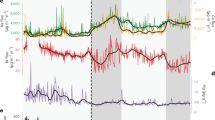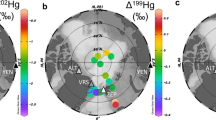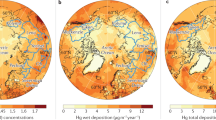Abstract
Mercury is a globally dispersed toxic metal that affects even remote polar areas. During seasonal atmospheric mercury depletion events in polar areas, mercury is removed from the atmosphere1,2 and subsequently deposited in the surface snows3. However, it is unknown whether these events, which have been documented for the past two decades, have occurred in the past. Here we show that over the past 670,000 years, atmospheric mercury deposition in surface snows was greater during the coldest climatic stages, coincident with the highest atmospheric dust loads. A probable explanation for this increased scavenging is that the oxidation of gaseous mercury by sea-salt-derived halogens occurred in the cold atmosphere. The oxidized mercury compounds were then transferred to the abundant mineral dust particles and deposited on the snowpack, leading to the depletion of gaseous mercury in the Antarctic atmosphere. We conclude that polar regions acted as a mercury sink during the coldest climatic stages, and that substantial polar deposition of atmospheric mercury is therefore not an exclusively recent phenomenon.
This is a preview of subscription content, access via your institution
Access options
Subscribe to this journal
Receive 12 print issues and online access
$259.00 per year
only $21.58 per issue
Buy this article
- Purchase on Springer Link
- Instant access to full article PDF
Prices may be subject to local taxes which are calculated during checkout


Similar content being viewed by others
References
Schroeder, J. P. et al. Arctic springtime depletion of mercury. Nature 394, 331–332 (1998).
Ebinghaus, R. et al. Antarctic springtime depletion of atmospheric mercury. Environ. Sci. Technol. 36, 1238–1244 (2002).
Lindberg, S. E. et al. Dynamic oxidation of gaseous mercury in the arctic troposphere at polar sunrise. Environ. Sci. Technol. 36, 1245–1256 (2002).
Boutron, C. F., Vandal, G. M., Fitzgerald, W. F. & Ferrari, C. A forty year record of mercury in central Greenland snow. Geophys. Res. Lett. 25, 3315–3318 (1998).
Vandal, G. M., Fitzgerald, W. F., Boutron, C. F. & Candelone, J. P. Variations in mercury deposition to Antarctica over the past 34,000 years. Nature 362, 621–623 (1993).
EPICA community members. Eight glacial cycles from an Antarctic ice core. Nature 429, 623–628 (2004).
Gabrielli, P. et al. Variations in atmospheric trace elements in Dome C (East Antarctica) ice over the last two climatic cycles. Atmos. Environ. 39, 6420–6429 (2005).
Lambert, F. et al. Dust-climate couplings over the past 800,000 years from the EPICA Dome C ice core. Nature 452, 616–619 (2008).
Fischer, H. et al. Reconstruction of millennial changes in dust emission, transport and regional sea ice coverage using the deep EPICA ice cores from the Atlantic and Indian Ocean sector of Antarctica. Earth Planet. Sci. Lett. 260, 340–354 (2007).
Wolff, E. W. et al. Southern Ocean sea-ice extent, productivity and iron flux over the past eight glacial cycles. Nature 440, 491–496 (2006).
Pongratz, P. & Heumann, K. G. Production of methylated mercury, lead and cadmium by marine bacteria as significant source for atmospheric heavy metals in polar regions. Chemosphere 39, 89–102 (1999).
St Louis, V. L. et al. Methylated mercury species in Canadian high Arctic marine surface waters and snowpacks. Environ. Sci. Technol. 41, 6433–6441 (2007).
Steffen, A. et al. A synthesis of atmospheric mercury depletion event chemistry in the atmosphere and snow. Atmos. Chem. Phys. 8, 1445–1482 (2008).
McConnell, J. C. et al. Photochemical bromine production implicated in Arctic boundary-layer ozone depletion. Nature 355, 150–152 (1992).
Rankin, A. M., Wolff, E. W. & Martin, S. Frost flowers: Implications for tropospheric chemistry and ice core interpretation. J. Geophys. Res. 107, 4683–4697 (2002).
Gauchard, P. A. et al. Study of the origin of atmospheric mercury depletion events recorded in Ny-Ålesund, Svalbard, spring 2003. Atmos. Environ. 39, 7620–7632 (2005).
Foster, K. L. et al. The role of Br2 and BrCl in surface ozone destruction at polar sunrise. Science 291, 471–474 (2001).
Saiz-Lopez, A. et al. Boundary layer halogens in coastal Antarctica. Science 317, 348–351 (2007).
Goodsite, M., Plane, J. M. C. & Skov, H. A theoretical study of the oxidation of Hg0 to HgBr2 in the troposphere. Environ. Sci. Technol. 38, 1772–1776 (2004).
Brooks, S. B. et al. The mass balance of mercury in the springtime Arctic environment. Geophys. Res. Lett. 33, L13812 (2006).
Jouzel, J. et al. Orbital and millennial Antarctic climate variability over the past 800,000 years. Science 317, 793–796 (2007).
Afeefy, H. Y., Liebman, J. F. & Stein, S. E. in NIST Chemistry WebBook (eds Linstrom, P. J. & Mallard, W. G.) (National Institute of Standards and Technology, 2009).
Planchon, F. et al. Direct determination of mercury at the sub-picogram per gram levels in polar snow and ice by ICP-SFMS. J. Anal. Atom. Spectrom. 19, 823–830 (2004).
Jitaru, P. & Adams, F. C. Speciation analysis of mercury by solid-phase microextraction and multicapillary gas chromatography hyphenated to inductively coupled plasma–time-of-flight-mass spectrometry. J. Chromatogr. A. 1055, 197–207 (2004).
Wedepohl, K. H. The composition of the continental crust. Geochim. Cosmochim. Acta 59, 1217–1232 (1995).
Pyle, D. M. & Mather, T. A. The importance of volcanic emissions for the global atmospheric mercury cycle. Atmos. Environ. 37, 5115–5124 (2003).
Gill, G. A. & Fitzgerald, W. F. Picomolar mercury measurements in seawater and other materials using stannous chloride reduction and two-stage gold amalgamation with gas phase detection. Mar. Chem. 20, 227–243 (1987).
Prospero, J. M., Savoie, D. L., Saltzman, E. S. & Larsen, R. Impact of oceanic sources of biogenic sulphur on sulphate aerosol concentrations at Mawson, Antarctica. Nature 350, 221–223 (1991).
Kim, J. P. & Fitzgerald, W. F. Sea-air partitioning of mercury in the Equatorial Pacific Ocean. Science 231, 1131–1133 (1986).
Cline, J. D. & Bates, T. S. Dimethyl sulfide in the equatorial pacific ocean: A natural source of sulfur to the atmosphere. Geophys. Res. Lett. 10, 949–952 (1983).
Acknowledgements
This work is a contribution to the ‘European Project for Ice Coring in Antarctica’ (EPICA), a joint ESF (European Science Foundation)/EU scientific programme, funded by the European Commission (EPICA-MIS) and by national contributions from Belgium, Denmark, France, Germany, Italy, the Netherlands, Norway, Sweden, Switzerland and the United Kingdom. This is the EPICA publication 222. In Belgium, the financial support is acknowledged from the Flemish Fund for Scientific Research (FWO), Brussels, Belgium; in France from the Institut Universitaire de France, the Ministère de l’Environnement et de l’Aménagement du Territoire, the Agence de l’Environnement et de la Maîtrise de l’Energie, the Institut National des Sciences de l’Univers, the French Polar Institute (IPEV) and the Université Joseph Fourier of Grenoble; in Italy, from the Consorzio per l’Attuazione del Programma Nazionale delle Ricerche in Antartide, under projects on Environmental Contamination and Glaciology. This research has also been supported by Marie Curie Fellowships of the European Community programme (contracts HPMF-CT-2002-01772, MEIF-CT-2006-024156). We acknowledge B. Delmonte, A. Dommergue, R. Ebinghaus, S. Lindberg, C. Temme and E. Wolff for useful comments. Finally, we would like to thank all of the scientific and logistic personnel of PNRA and IPEV working at Dome C, Antarctica.
Author information
Authors and Affiliations
Contributions
C.F.B., C.B., C.P.F., P.C. and F.C.A. planned the project; P.G., A.M., P.-A.G. and S.H. carried out sample preparation; P.G., A.M. and F.A.M.P. determined total mercury; P.J. carried out mercury speciation; P.G., J.M.C.P., C.B. and P.J. carried out the data interpretation and wrote the paper.
Corresponding author
Supplementary information
Supplementary Table S1
Supplementary Information (PDF 354 kb)
Rights and permissions
About this article
Cite this article
Jitaru, P., Gabrielli, P., Marteel, A. et al. Atmospheric depletion of mercury over Antarctica during glacial periods. Nature Geosci 2, 505–508 (2009). https://doi.org/10.1038/ngeo549
Received:
Accepted:
Published:
Issue Date:
DOI: https://doi.org/10.1038/ngeo549
This article is cited by
-
A 1500-year record of mercury isotopes in seal feces documents sea ice changes in the Antarctic
Communications Earth & Environment (2023)
-
Arctic mercury flux increased through the Last Glacial Termination with a warming climate
Nature Geoscience (2023)
-
Mercury wet depositions study at suburban, agriculture and traffic sampling sites
Environmental Geochemistry and Health (2021)
-
Natural versus anthropogenic influence on trace elemental concentration in precipitation at Dokriani Glacier, central Himalaya, India
Environmental Science and Pollution Research (2020)
-
Evidence of air-snow mercury exchange recorded in the snowpack at Dome Fuji, Antarctica
Geosciences Journal (2014)



